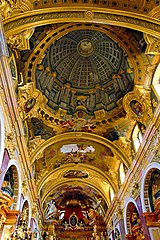Architectural painting
In the Renaissance, architecture was used to emphasize the perspective and create a sense of depth, like in Masaccio's Holy Trinity from the 1420s.
Closely related genres are architectural fantasies and trompe-l'oeils, especially illusionistic ceiling painting, and cityscapes.
[3] Students of Hans Vredeman de Vries, both in Flanders and in the Netherlands, include his sons Salomon and Paul, and Hendrik van Steenwijk I.
Through them the genre was popularized and their family and students turned it into one of the main domains of Dutch Golden Age painting.
Notable Dutch painter of the genre include: Architectural paintings, and the related vedute or cityscapes, were especially popular in 18th century Italy.







